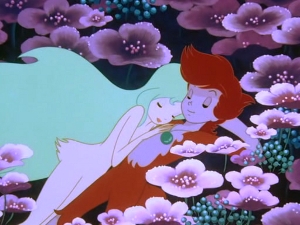
Forget Akira. Forget Ghost in the Shell. Forget Evangelion, Gundam and GTO. Forget all the titles otaku mention when they grip you by the lapels and insist “You have to see this!” This was my introduction to anime and I found it in the same place I found everything else: my long-vanished, small town video store. And like many a film that traumatized me in early childhood, I’d managed to almost completely forget about Sea Prince and the Fire Child.
Then little over a month ago my best friend’s wife and I got to talking about movies that traumatized us as children. Despite growing up half a continent away, both of us managed to find this film at exactly the same time. As usual, she remembered, I repressed, with the repression manifesting itself as an irrational hatred of The Little Mermaid I could never really explain…until now.
Sea Prince and the Fire Child (or Sirius no Densetsu: “The Legend of Sirius“) is the film The Little Mermaid might’ve been were it not shackled to Disney. The Little Mermaid would gladly sell its voice (and soul) to an evil octopus-witch just on the off chance it might have one tenth of Sea Prince‘s emotional impact. Unfortunately, Disney makes films for children and, since they’re primarily American children, Disney assumes they’re all fools. They proceed from a false assumption. And as American children grow up, they have an unfortunate habit of learning when they’re being talked down to. They come to hate the implied insult in most of Western animation.

And that, more than anything I think, is what creates otaku: the belief that anime – however obtuse and nonsensical it might sometimes be – does not treat us with kid gloves. It expects us to be thoughtful. Doesn’t make the movies any better, but I prefer to be accidentally insulted by my entertainment. Damnit, Jim, I’m a doctor, not a kid anymore.
Sea Prince and the Fire Child opens with the obligatory prologue, complete with the obligatory, “Once upon a time…as they say…” Once upon a time (as Our Humble Narrator says), the gods of Fire and Water enjoyed the kind of creepy, incestuous relationship royal families (and their gods) favored for thousands upon thousands of years the world over. Fire and Water lived in consequential harmony, and it was all so boring Algorac, the God of Winds, decided to shake things up a bit.
Playing the Iago, Algorac turned Oceanus, the King of Waters, against his sister/lover, Hyperia, the Queen of Fire. The resulting war threatened to wipe Hyperia’s children off the map and extinguish Fire forever. To ward this (and Oceanus) off, Hyperia created a Holy Flame that, according to Her Highness, “must be watched well, for as long as it burns the sea will be calm and the Children of Fire shall live.”
Years later, we meet Sirius (Tôru Furuya originally; Tony Oliver in the English dub), Prince of the Water People and Oceanus’ heir. Actually, we meet our Odious Comic Relief, Sirius’ (brother? friend? cousin? sympathy-case?) Bibel, first. Bibel wakes the young Prince out of bed because Sirius promised to take him “hunting” and Bibel’s a lot like the young Lion King, Simba: entitled and annoying. His voice in the English dub makes things worse by being so high-pitched and grating I’d wake up out of a Dead Zone coma just to shut the little bastard up.
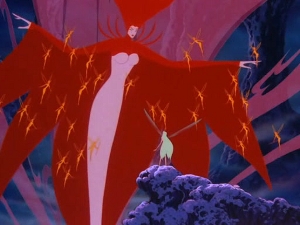
After swimming/flying through the absurd geography of King Oceanus’ domain (waterfalls under water? Clouds inside the ocean? Hey, that’s Anime), Sirius gets Bibel into a fight with an enormous (but perfectly innocent) jellyfish. Like any good children of an absolutist monarchy, these two run around getting their jollies from torturing the subject classes. The jellyfish flees and Our “Heroes” pursue it the edge of the Forbidden Zone.
Unfortunately, it’s not the one from Krypton . This Forbidden Zone marks the border between the Kingdoms of Fire and Water. In our world we call those “shores” but hey, who am I to judge? In this world, the Zone also functions as a prison for Algorac, who’s lain there ever since the King of Gods gave him a righteous beat down for precipitating the Great War. The One True God also removed one of Algorac’s eyes, entrusting it to Oceanus…for some reason. It’s thus become a badge of office for the Sea People, held in trust by their King.
Sirius rightly leaves Bibel behind and travels through the strange, red-tinged, cloudy-looking Zone by himself. It’s a demon-haunted, incredibly boring place, with the only landmark of distinction being the skeleton of the original Godzilla, picked clean by Dr. Serizawa’s Oxygen Destroyer. Eventually, Sirius finds a light to steer by. No surprise it’s the Holy Flame…being tended – no surprise here either – by the Fire Queen’s one-and-only daughter (by whom?), Malta. Oh, and her Bibel-analog: a pronoun-deficient fairy named Piale (Keiko Han).
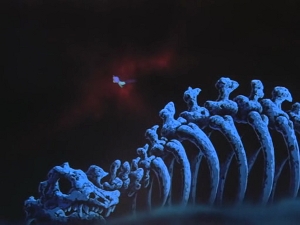
“From forth the fatal loins of these two foes, a pair of star-cross’d lovers take their life; whose misadventur’d piteous overthrows doth with their death bury their parents’ strife”
Or is quoting Romeo and Juliet too much of a spoiler? Too bad. You should’ve already figured that out from the title. I’m sure there are more blatant ways to scream “elemental fantasy retelling of Romeo and Juliet” but I can’t think of any at the moment and no one’s paying me to try.
That being the case, one glimpse of each other is all Our Lovers need to overcome the generational prejudice of their homelands and fall in syrupy, middle-school lust…dooming their respective kingdom’s to tragedy. This particularly sucks for the Sea People since Prince Sirius’ birthday soon arrives, and for his sweet sixteen King Oceanus gives the Sea Prince Algoroc’s Eye and the title King of the Sea People…whatever that means. Has Oceanus abdicated? Or is Sirius just some regent, keeping the masses pacified while dad deals with the big problems besetting Water everywhere? Whatever the case, this turn of events disgusts the Sea People’s resident bully and all around heal, Mugwump “the Magnificent.” Mugwump is a (crocodile? newt? or evolutionary holdover?) who feels he’d be much better King than Sirius…with good reason, as it turns out. At least we know Mugwump’s not going to be off chasing tail when the Sea People need defending.
Back on land, things are looking just as bad for the Fire People. Malta, too, is about to hit the big one-six, her birthday coinciding with an upcoming eclipse. This’ll signal the passing of the royal torch from mother to daughter, meaning Malta will soon have no time (or reason) to guard the Holy Flame, what with her plateful of Queenly responsibilities (like lounging about while flocks of fairies tend to her every need).

So what we have here are two kingdoms who’ve learned the meaning of “war is peace”. When they first meet, Our Lovers each express surprise that the other isn’t as “savage” as royal propaganda indicated. Both conceal their nightly meetings at the Holy Flame and (eventually) plan to run away together…despite having nowhere to go. Both jeopardize the sanctity of their respective kingdoms. Sirius gallivants through a field of flowers when he should be protecting the Sea People from jellyfish attack (an attack he and Bibel obviously provoked with their earlier irresponsibility, no less). Malta neglects the Holy Flame so that she and Sirius might play Twilight with each other. In the end, both become fugitives pursued by their parent’s forces after both the Odious Comic Relief characters turn into scumsucking narcs. Oh, don’t be worried: both redeem themselves with Noble Sacrifices later on.
Technically, Sirius no Densetsu was one hell of an achievement for its time (and budget), still managing to hold out well in the face of today’s computer-generated-image orgies. There’s not a speedline to be seen, and for all the crap I give Disney (here and elsewhere) I have to admit this is a very Disney-esque production.
The design of the humanoid characters certainly owes a lot to Disney’s mid-century art style, translated through the pen of (who else?) Osamu Tezuka, God of Comics. If one were being uncharitable one could see Bibel as a straight rip-off of Tezuka’s Unico, Sirius as the bishonen Peter Pan, and Malta as Snow White of the Faires. If one were being charitable, one could see the whole thing as a Shinto retelling of a star-crossed lovers yarn that was old when Shakespeare stole it. Hyperia is obviously Amaterasu, making Algorac her evil brother, Susanoo. Oceanus has a little Susanoo in him too, though he’s mostly an aspect of the Dragon God, Watasumi, whom I first knew as Ryujin.

All of which went right over my head as a child. The epic, fantastical scope of these mythological trappings didn’t. It’s hard to think up snarky questions when I’m busy watching an army of fairies pursue Our Loves through a desolate, Sha Ka Ree-looking wasteland. Or seeing evil, elemental gods escape the red nimbus of their undersea prisons (destroying Godzilla’s skeleton in the process – damnit, now the Sea People will never be able to build their own Mechagodzilla. It would’ve been perfect. Queen Hyperia and her Sugar Plum Legions would’ve shit themselves in fear at the sight of a three hundred foot robot with a freeze cannon in its chest). These are not things you see everyday, and they’re beyond the scope of most animated features.
Still, I can’t help but wonder why all these star-crossed lovers don’t just wait until they’ve ascended to their respective thrones? Then they could declare peace, start popping out babies, and mollify Mom and Dad with a bushel of mutant grandkids. And why does no one in this story answer Our Lover’s frequent questions about the status quo until it’s too late? Everyone must know about the Great War, yet Sirius and Malt both feel the need to ask why the Children of Fire and Water can never be together, or what gives with all the antipathy? A straight answer to either one of them at any point in the film would cut right through this Gordian knot and save everybody some heartbreak…so instead, we get failure, betrayal, and foot chases through minimalist, fantasy landscapes stolen from progressive rock album covers from the late 1970s.
That said, this is still the early-80s, so parts of the film – even those that cost millions of yen to produce – look astonishingly cheap today. The backgrounds are sparse to the point of austerity, along with most of the characters. Main speaking roles take precedence, obviously, and they’re simple for the most part, becoming epically and fantastically expressive only when the script requires. I like the designs of Oceanus and Hyperia the best because, as gods, they’re not slave to the perpetual cuteness that’s suppose to make their children loveable. Oceanus is a Dragon God to contend with. We even see him knock out his evil god-brother with one punch. And Hyperia…there’s really no good way to say this, but I honestly thought it at the time and still think so today…Hyperia has a rack fit for her office.
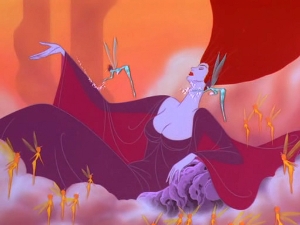
Still, there’s some obvious cost-cutting measures throughout that seem even more obvious these days. Sometimes this works for the film, as with the various Sea Creatures, only a few of whom (Mugwump, Bibel, and the wise old sage, Aris Turtle) are anthropomorphized to an extent comparable to contemporary Disney, lip movements being so expensive and all. Back on land, I can honestly say, “All the Fire People look alike to me,” without being a racist…cuz damnit, they do, and by design. It’s creepier when they all swarm together for the final chase anyway. As anyone who actually reads fairy tales should know, one fairy is trouble. A whole army of them is a mini-Apocalypse waiting to happen. I’d run through the dark side of the moon, too.
The most flagrant example of cheapness comes three-quarters of the way through, after Our Lovers love, Mugwump’s duplicity, and Bibel’s stupidity align to free Algorac from the Forbidden Zone. You can’t really call this a spoiler since the movie’s Big Bad – the being that tore two gods apart and prompted a full-on, elemental war that almost decimated the Earth, requiring the intercession of He Who Must Only Be Hinted At – gets dispatched with one blow from King Oceanus’ trident. And he’s never mentioned again. Can you say, “letdown?” Here I was, expecting a full-on God Fight, only to find Algorac has a glass jaw.
Now, you could argue that Algorac is just a Big Bad MacGuffin, a necessary plot contrivance. He exists to get things started and keep them from going into autopilot. You’d be right, and you’ve exposed the fundamental flaw of Sea Prince and the Fire Child: it’s a house built of contrivance. Malta is a manipulative bitch when she’s not getting all weepy over the Doom she’s bringing down upon her people. Sirius is a arrogant layabout with nothing on his mind besides new ways of torturing the populace…until he meets A Girl, whereupon his IQ sinks right through the ocean floor faster than a mob informant in cement shows. You could almost see the wheels turning: “She’s talking to me? My God, this has never happened before! What do I do? I know! I’ll stand here and look like a stroke victim. That’s sure to impress her!” Malta, in true female cartoon character fashion, finds this open-mouthed staring “cute.” Don’t all fifteen-year-old girls love it when boys leer at them with slack-jawed amazement? Back in the long, long ago, when I was fifteen, all I got for that was a corrective smack across the face and the occasional, “My eyes are up here, thank you. Gawd, what an asshole!”
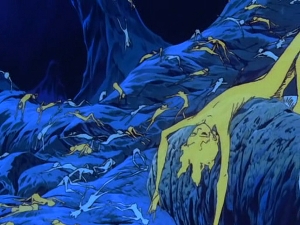
Befitting royals of their station, neither is the smartest pen in the drawer. For one thing, while debating their great Run for the Border, Sirius and Malta have no where to go…until the wise old Aris Turtle, the oldest creature in the Seas rises to the surface to finally explain everything, making the opening prologue redundant, recapping the Story So Far and flat out telling Our Lovers where to go, since they’re too dumb to figure it out for themselves. Later in the film, as Our Lovers flee from Hyperia’s Fairy Army. Malta – despite having wings and the ability to use them – still manages trip and fall, requiring Sirius’ assistance in true Damsel in Distress fashion. I half-expected her to swoon next.
Incidentlaly, Aris Turtle makes one hell of a turn-about, going from “you can’t get it on, it’s the law!” to “the power of love conquers all!” in the space seconds. Another cost-cutting measure? Or mere script contrivance? He’s about the only character I really liked among the Sea People, and he gets all of two scenes.
Despite everything I’ve said, the film’s well-executed. Its most Odious bits of come early on and, halfway through, stop dead…literally. It’s no wonder Young Me loved this movie: both the Odious Comic Relief characters die. And, since this is anime, they die nobly sacrificing themselves for their respective lord and lady as payback for selling them out to their parents a few scenes earlier. And they stay dead.
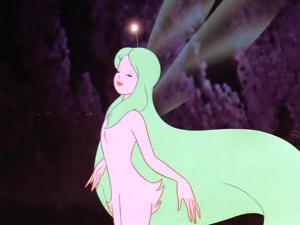
I can lay most of my annoyance with them at the feet of this film’s dubbing anyway. The dub has all the problems you’d expect from anime of this vintage: too-literal translation, awkward lines meant to match lips, and one out and proud Dramatic Speech given to King Oceanus that tries its hardest to ruin the ending. Oceanus’ lips don’t move when he speaks, giving the dubbers a natural opportunity to lighten the emotional load this film meant to leave in our hands…but why in the name of Holy Flame did they want to do a thing like that? Keeping the Sea King silent and letting the score speak for itself would’ve been much more powerful. What the hell is the point of having the NHK Symphony Orchestra score your fantasy epic if you’re just going to put dialogue over their great music? Every kid with a dead pet knows their ain’t no coming back and the stars aren’t going to save us or embrace our dead souls. Besides, all we ever see of stars are their old photographs…
Both minimalist and epic, Sea Prince and the Fire Child manages to be sparse in its particulars so that a general grandeur can pervade. This, and the tonal shift half way through, propelling things toward the inevitable Romeo and Juliet conclusion, elevate the film above its contemporary American competition. While not great (it’s sure as shit no Evangelion) it remains one of the greatest, guilt-free ways I know of traumatizing children. It certainly did wonders for me. See what it does to you and yours.
![]()
![]()
![]()

Love the review! I need to seek this one out.
Thank you. Yes, you do. Everyone need to seek this out, but good luck finding it anywhere other than amazon.co.jp. If enough of us clamor, whoever owns this movie might eventually get a bug up their butt and realize they’ve got a ready-built audience of nostalgic young-adults who saw this in the 80s and now stand poised and ready to traumatize their children in the 2010s.
It is on YOututbe!:)
Very helpful review. I had no trouble finding a DVD on Amazon US, as there was a “30th anniversary” reissue in 2011. The parallels you make to Disney’s “Little Mermaid” are interesting: the director, Masami Hata, did a version of this tale as part of the 1971 TV series “Andersen Monogatari” [The Tales of Hans Christian Andersen] and Disney’s animators are widely said to have borrowed ideas from their more inventive Japanese fellows.
Holy crap. Bill, thanks for that. I honestly had no idea Andersen Monogatari even existed, much less that Masami Hata came out of that…though it makes sense he’d pay his TV dues before moving up to features.
As far as the Disney stuff goes…I am Jack’s complete lack of surprise.
This movie was my childhood and I’ve watched it a bout ten times! One of my favorite childhood movies, but no one else that I know has heard of it.
I know the feeling – classic anime fans seem to be all about the Gundam or the Robotech or the Voltron. Shows that never aired in my geographic market. But this, Taro the Dragon Boy and Unico, was readily available at my local video store, and I watched them far too many times growing up, in between viewings of RoboCop and the G.I. Joe “movie.”
I watched this hundreds of times between age 4 1/2 and 8, and still like to delight friends with retelling the story in all of the voices an acting ot out. IT IS most definitely a long – borrowed story and has quite a bit of hokiness, but for all that–and my amusement with your review–holds a special place in my heart.
I really thought the art was incredible in this movie. I came upon it on accident doing a word search in the Crunchyroll app. I couldn’t get over how “Disney” it felt and then characters DIE and I guess that was the magic combination for me. I instantly wanted it for my collection (That’s supposed to mean something since I don’t normally want to buy discs when I’ve already found a way to view it once. ) I didn’t then, nor now have the background of knowledge you did David when I viewed this. When you go the “Anime route” you have to drop judgements and let the story and characters caramelize together and when it’s over, if you feel the need regurgitate up what you got out of it as whether you liked it. I was a bit confused how you waled against the film, but then happily recommend it to others. Even after reading your whole impression of the film on you, I wondered just in what ways this film traumatized you. I also feel that “young and in love” trumps any kind of common sense or more efficient occurrence to a more direct result as to why things played-out as they did. In other words, just because you can “fix the storyline” doesn’t mean it’s broken. It is much more realistic in my opinion that things don’t work-out and that there is in your words a “Gordian knot” present. 20/20 in hind-sight as they say. I also got an impression that the “fire child” of this film when she was bequeathed the throne actually went through some kind of physical (possibly affecting her very brain chemistry ) transformation rendering her unable to feel the things for the Sea prince prior to that. But it was just my impression. I thought the same thing about the turtle’s change in ethics that you mentioned. It seems, no matter how devout a law-abider, the character is in this film Love is almighty.